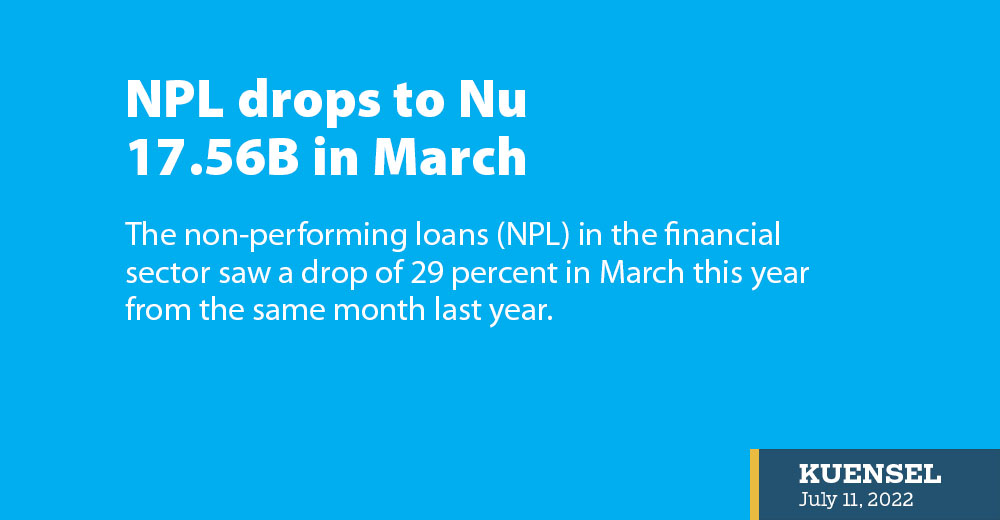Thukten Zangpo
The non-performing loans (NPL) in the financial sector saw a drop of 29 percent in March this year from the same month last year.
Statistics from the Royal Monetary Authority’s (RMA) financial sector performance report show NPL of Nu 17.56 billion (B)—Nu 10.64B with banks and Nu 6.92B with non-bank financial institutions in March.
In the same month last year, NPL stood at Nu 24.75B.
NPL are loans with payments that are overdue by 90 days or more.
NPL ratio to the total credit in the economy reduced to 9.78 percent in March from 14.58 percent in the same month last year. The total credit as of March stood at Nu 179. 57B.
According to the report, the NPL decreased mainly on account of formulation and application of robust monetary measures (Phases I, II, and III) which enabled the availability of relief measures in the form of interest payment support, loan restructuring, and rescheduling, and deferment.
However, the impact of the pandemic on the NPL is expected to be a key challenge, the report added.
The production and manufacturing, trade and commerce, service and tourism sectors saw a huge decrease in NPL, Nu 2B, Nu 1.42B, and Nu 1.44B, respectively. It was found that these sectors accounted for over 50 percent of the total loans and were impacted by the Covid-19 pandemic.
NPL in the service and tourism sector in March stood at Nu 5.8B, accounting for 33 percent of the total NPL. Credit in the service and tourism sector amounted to Nu 49.6B.
NPL in the trade and commerce sector stood at Nu 3.4B, 19 percent of the total NPL; credit to the sector was Nu 21.1B.
Housing saw Nu 2.23B NPL while the credit to the sector was Nu 46.95B.
NPL in the transport sector saw a decrease of 28.92 percent—Nu 1.25B from Nu 1.75B in March last year.
Because of high NPL, the RMA, in May, directed the three financial institutions, namely Bhutan Development Bank Limited, Royal Insurance Corporation of Bhutan Limited, and National Cottage and Small Industry (CSI) Development Bank, to temporarily freeze disbursing loans.
National CSI Development Bank Limited’s chief executive officer, Kinzang, said that the bank submitted remedial measures to the RMA. He added that the NPL ratio to the total loans saw an improvement from 11 percent in March to 9 percent in June. The central bank’s threshold for NPL is 5 percent for the bank.
“We are trying to bring down the NPL. The cash repayment we receive from people has improved. The repayment of Nu 30 million (M) in March improved to Nu 50M in June,” Kinzang said, adding that the bank also follows pre-emptive measures by calling and reminding people of their equated monthly installment.
To resolve NPL, the RMA had come up with the three regulations—Rules and Rules and Regulations for Loan Restructuring 2022, Rules and Regulations on Foreclosure and Write-off of NPLs 2022, and Guidelines on the Reclassification of old NPLs 2022 guided by the NPL Resolution Framework.
The framework aimed to support and rehabilitate viable NPL through loan restructuring measures while resolving non-viable loans through various foreclosure means such as court or out-of-court settlements.
“Extending relief measures to NPL without careful consideration would only defer the problems temporarily without necessarily resolving underlying issues. And in the process, the borrowers are often burdened with growing indebtedness, causing social concerns,” the standard operating procedures for the implementation of phase IV monetary measures stated.
According to the report, the financial institutions’ profit after tax increased by almost double to Nu 3.37B in March this year from Nu 1.63B in March last year. “The profit was mainly due to decrease in NPL which subsequently resulted in write-back of loan provision by Nu 800M.”


